Gallery
Image Type
Morphological Structure
Clades
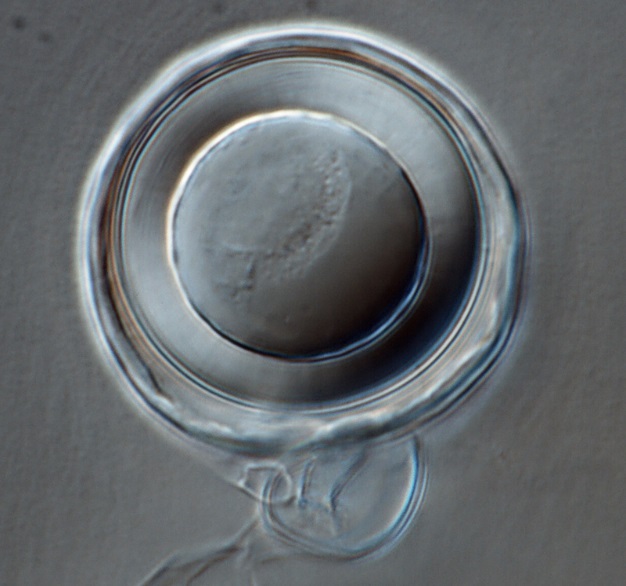 Phytophthora erythroseptica nbsp;(CPHST BL 36G, selected specimen) sexual phase:nbsp;oogoniumnbsp;with amphigynous antheridiumnbsp;and aplerotic oospore; photonbsp;by Gloria Abad, USDA-APHIS-PPQ.
Phytophthora erythroseptica nbsp;(CPHST BL 36G, selected specimen) sexual phase:nbsp;oogoniumnbsp;with amphigynous antheridiumnbsp;and aplerotic oospore; photonbsp;by Gloria Abad, USDA-APHIS-PPQ.
Phytophthora erythroseptica (CPHST BL 36G, selected specimen) sexual phase: oogonium with amphigynous antheridium and aplerotic oospore; photo by Gloria Abad, USDA-APHIS-PPQ.
 Phytophthora erythroseptica nbsp;(CPHST BL 36G, selected specimen) sexual phase: oogonium with amphigynous antheridium with digitate projection and aplerotic oospore; photonbsp;by Gloria Abad, USDA-APHIS-PPQ.
Phytophthora erythroseptica nbsp;(CPHST BL 36G, selected specimen) sexual phase: oogonium with amphigynous antheridium with digitate projection and aplerotic oospore; photonbsp;by Gloria Abad, USDA-APHIS-PPQ.
Phytophthora erythroseptica (CPHST BL 36G, selected specimen) sexual phase: oogonium with amphigynous antheridium with digitate projection and aplerotic oospore; photo by Gloria Abad, USDA-APHIS-PPQ.
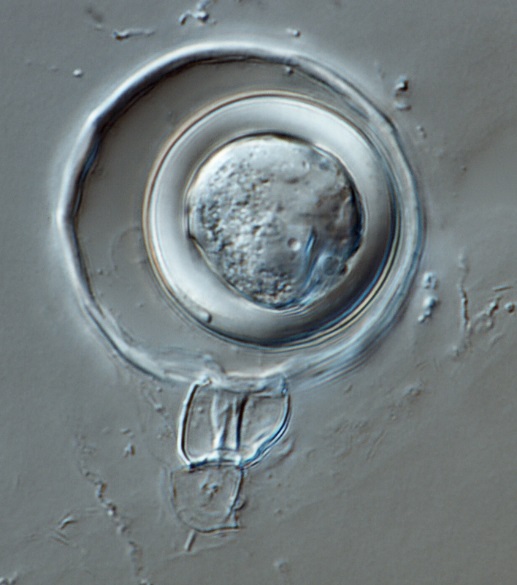 Phytophthora erythroseptica nbsp;(CPHST BL 36G, selected specimen) sexual phase:nbsp;oogoniumnbsp;with amphigynous antheridiumnbsp;and aplerotic oospore; photonbsp;by Gloria Abad, USDA-APHIS-PPQ.
Phytophthora erythroseptica nbsp;(CPHST BL 36G, selected specimen) sexual phase:nbsp;oogoniumnbsp;with amphigynous antheridiumnbsp;and aplerotic oospore; photonbsp;by Gloria Abad, USDA-APHIS-PPQ.
Phytophthora erythroseptica (CPHST BL 36G, selected specimen) sexual phase: oogonium with amphigynous antheridium and aplerotic oospore; photo by Gloria Abad, USDA-APHIS-PPQ.
Phytophthora spp. in subclade 9a: portion of the seven-loci ML phylogeny featuring the type cultures of 212 described species (by T. Bourret). Notice the position of P. estuarina Ex-type CCIBt 4157. Gloria Abad, USDA S&T.
Phytophthora spp. in subclade 9a: Morphological Tabular key (PDF) and Tabular key legends (PDF) in IDphy2 KEY SECTION. Notice the data of P. estuarina Ex-type CCIBt 4157. Gloria Abad, USDA S&T.
Phytophthora spp. in subclade 7a: portion of the seven-loci ML phylogeny featuring the type cultures of 212 described species (by T. Bourret). Notice the position of P. europaea Ex-type CBS 109049 = S&T BL 37G. Gloria Abad, USDA S&T.
Phytophthora spp. in subclade 7a: Morphological Tabular key (PDF) and Tabular key legends (PDF) in IDphy2 KEY SECTION. Notice the data of P. europaea Ex-type CBS 109049 = S&T BL 37G. Gloria Abad, USDA S&T.
 Phytophthora europaea (CPHST BL 37G) colonies of the ex-type grown for 7 days on (a) V8reg; Agar, (b) potato dextrose agar, and (c) malt extract agar; photo by Krysta Jennings and Leandra Knight, USDA-APHIS-PPQ
Phytophthora europaea (CPHST BL 37G) colonies of the ex-type grown for 7 days on (a) V8reg; Agar, (b) potato dextrose agar, and (c) malt extract agar; photo by Krysta Jennings and Leandra Knight, USDA-APHIS-PPQ
Phytophthora europaea (CPHST BL 37G) colonies of the ex-type grown for 7 days on (a) V8® Agar, (b) potato dextrose agar, and (c) malt extract agar; photo by Krysta Jennings and Leandra Knight, USDA-APHIS-PPQ
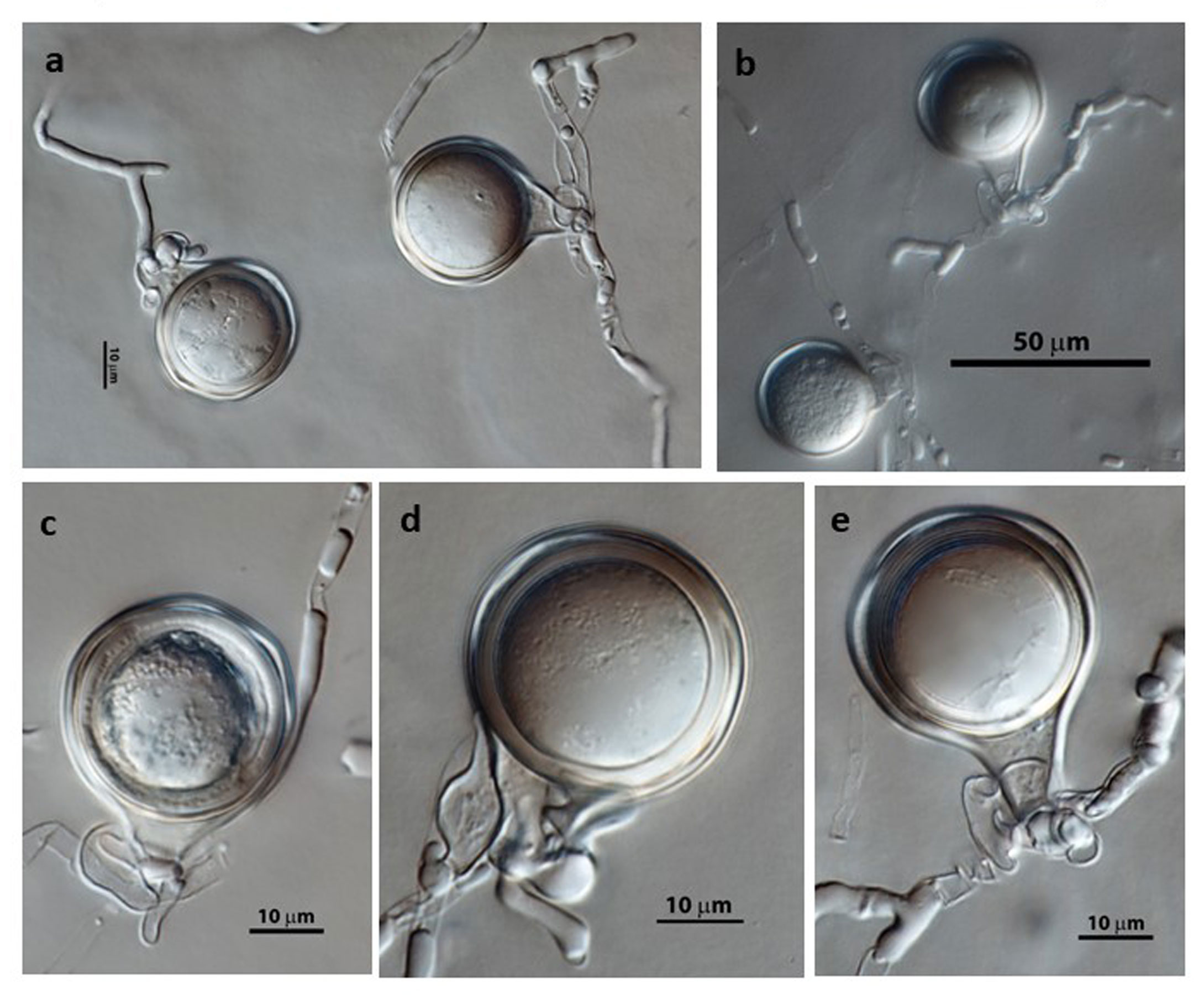 Phytophthora europaea (CPHST BL 37G) sexual phase of the ex-type (andash;e); photos by Vickie Brewster, USDA APHIS PPQ
Phytophthora europaea (CPHST BL 37G) sexual phase of the ex-type (andash;e); photos by Vickie Brewster, USDA APHIS PPQ
Phytophthora europaea (CPHST BL 37G) sexual phase of the ex-type (a–e); photos by Vickie Brewster, USDA APHIS PPQ
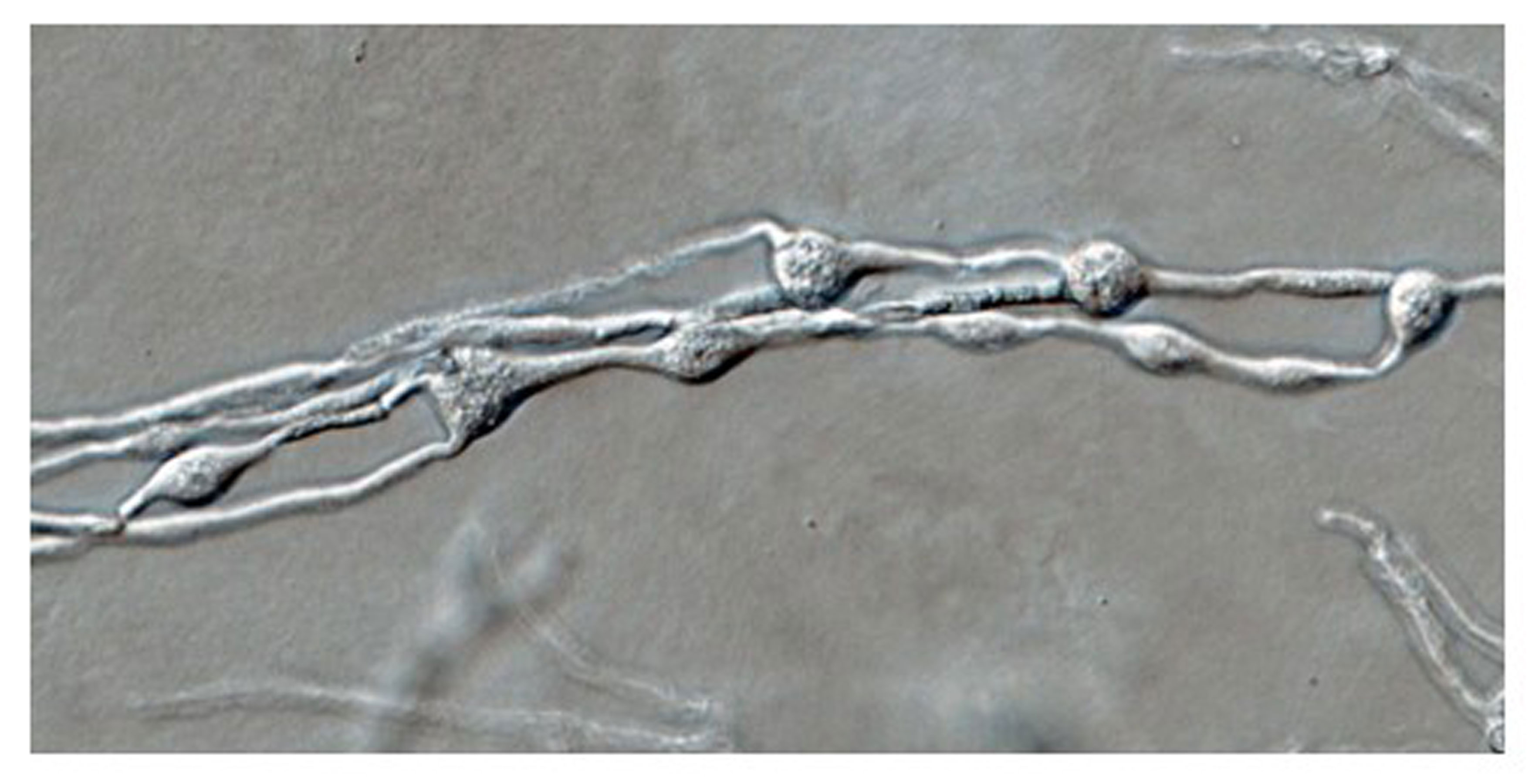 Phytophthora europaea (CPHST BL 37G) asexual phase of the ex-type with hyphal swellings; photo by Vickie Brewster, USDA APHIS PPQ
Phytophthora europaea (CPHST BL 37G) asexual phase of the ex-type with hyphal swellings; photo by Vickie Brewster, USDA APHIS PPQ
Phytophthora europaea (CPHST BL 37G) asexual phase of the ex-type with hyphal swellings; photo by Vickie Brewster, USDA APHIS PPQ
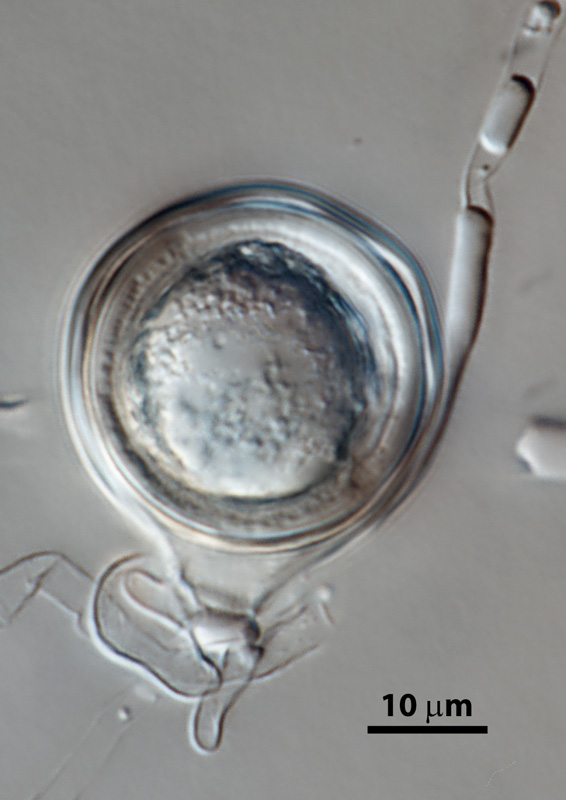 Phytophthora europaea nbsp;(CPHST BL 37G) sexual phase of the ex-type: plerotic oospore, oogoniumnbsp;with tapered base, and paragynous antheridium; photonbsp;by Vickie Brewster, USDA APHIS PPQ.
Phytophthora europaea nbsp;(CPHST BL 37G) sexual phase of the ex-type: plerotic oospore, oogoniumnbsp;with tapered base, and paragynous antheridium; photonbsp;by Vickie Brewster, USDA APHIS PPQ.
Phytophthora europaea (CPHST BL 37G) sexual phase of the ex-type: plerotic oospore, oogonium with tapered base, and paragynous antheridium; photo by Vickie Brewster, USDA APHIS PPQ.
 Phytophthora europaea nbsp;(CPHST BL 37G) sexual phase of the ex-type: plerotic oospores, oogonianbsp;with tapered bases, and paragynous antheridia; photonbsp;by Vickie Brewster, USDA APHIS PPQ.
Phytophthora europaea nbsp;(CPHST BL 37G) sexual phase of the ex-type: plerotic oospores, oogonianbsp;with tapered bases, and paragynous antheridia; photonbsp;by Vickie Brewster, USDA APHIS PPQ.
Phytophthora europaea (CPHST BL 37G) sexual phase of the ex-type: plerotic oospores, oogonia with tapered bases, and paragynous antheridia; photo by Vickie Brewster, USDA APHIS PPQ.
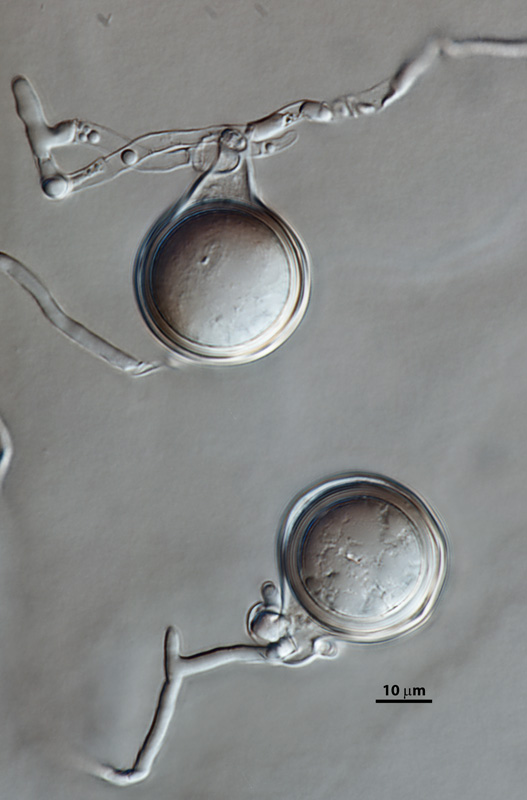 Phytophthora europaea nbsp;(CPHST BL 37G) sexual phase of the ex-type: plerotic oospores, oogonianbsp;with tapered bases, and paragynous antheridia; photonbsp;by Vickie Brewster, USDA APHIS PPQ.
Phytophthora europaea nbsp;(CPHST BL 37G) sexual phase of the ex-type: plerotic oospores, oogonianbsp;with tapered bases, and paragynous antheridia; photonbsp;by Vickie Brewster, USDA APHIS PPQ.
Phytophthora europaea (CPHST BL 37G) sexual phase of the ex-type: plerotic oospores, oogonia with tapered bases, and paragynous antheridia; photo by Vickie Brewster, USDA APHIS PPQ.
 Phytophthora europaea nbsp;(CPHST BL 37G) sexual phase of the ex-type: plerotic oospore, oogoniumnbsp;with tapered base, and paragynous antheridium; photonbsp;by Vickie Brewster, USDA APHIS PPQ.
Phytophthora europaea nbsp;(CPHST BL 37G) sexual phase of the ex-type: plerotic oospore, oogoniumnbsp;with tapered base, and paragynous antheridium; photonbsp;by Vickie Brewster, USDA APHIS PPQ.
Phytophthora europaea (CPHST BL 37G) sexual phase of the ex-type: plerotic oospore, oogonium with tapered base, and paragynous antheridium; photo by Vickie Brewster, USDA APHIS PPQ.
 Phytophthora europaea nbsp;(CPHST BL 37G) sexual phase of the ex-type: plerotic oospore, oogoniumnbsp;with tapered base, and paragynous antheridium; photonbsp;by Vickie Brewster, USDA APHIS PPQ.
Phytophthora europaea nbsp;(CPHST BL 37G) sexual phase of the ex-type: plerotic oospore, oogoniumnbsp;with tapered base, and paragynous antheridium; photonbsp;by Vickie Brewster, USDA APHIS PPQ.
Phytophthora europaea (CPHST BL 37G) sexual phase of the ex-type: plerotic oospore, oogonium with tapered base, and paragynous antheridium; photo by Vickie Brewster, USDA APHIS PPQ.
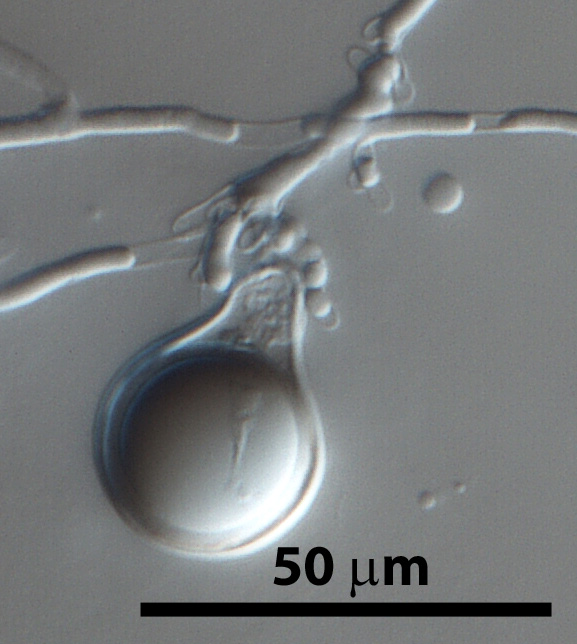 Phytophthora europaea nbsp;(CPHST BL 37G) sexual phase of the ex-type: plerotic oospore, oogoniumnbsp;with tapered base, and paragynous antheridium; photonbsp;by Vickie Brewster, USDA APHIS PPQ.
Phytophthora europaea nbsp;(CPHST BL 37G) sexual phase of the ex-type: plerotic oospore, oogoniumnbsp;with tapered base, and paragynous antheridium; photonbsp;by Vickie Brewster, USDA APHIS PPQ.
Phytophthora europaea (CPHST BL 37G) sexual phase of the ex-type: plerotic oospore, oogonium with tapered base, and paragynous antheridium; photo by Vickie Brewster, USDA APHIS PPQ.
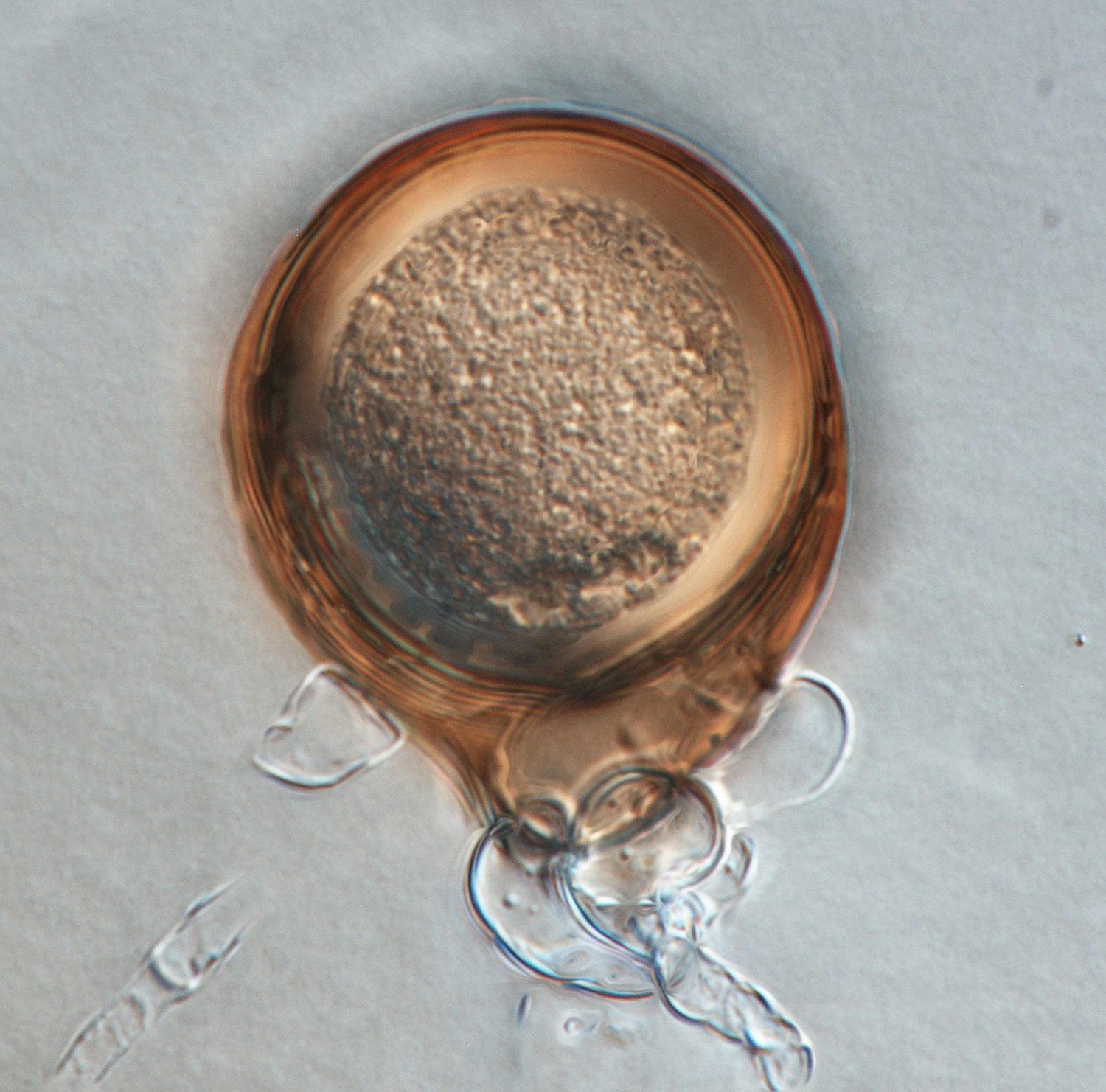 Phytophthora europaea nbsp;(CPHST BL 37G) sexual phase of the ex-type: older golden-brown plerotic oospore, oogonium with tapered base, and paragynous antheridium; photonbsp;by Vickie Brewster, USDA APHIS PPQ.
Phytophthora europaea nbsp;(CPHST BL 37G) sexual phase of the ex-type: older golden-brown plerotic oospore, oogonium with tapered base, and paragynous antheridium; photonbsp;by Vickie Brewster, USDA APHIS PPQ.
Phytophthora europaea (CPHST BL 37G) sexual phase of the ex-type: older golden-brown plerotic oospore, oogonium with tapered base, and paragynous antheridium; photo by Vickie Brewster, USDA APHIS PPQ.
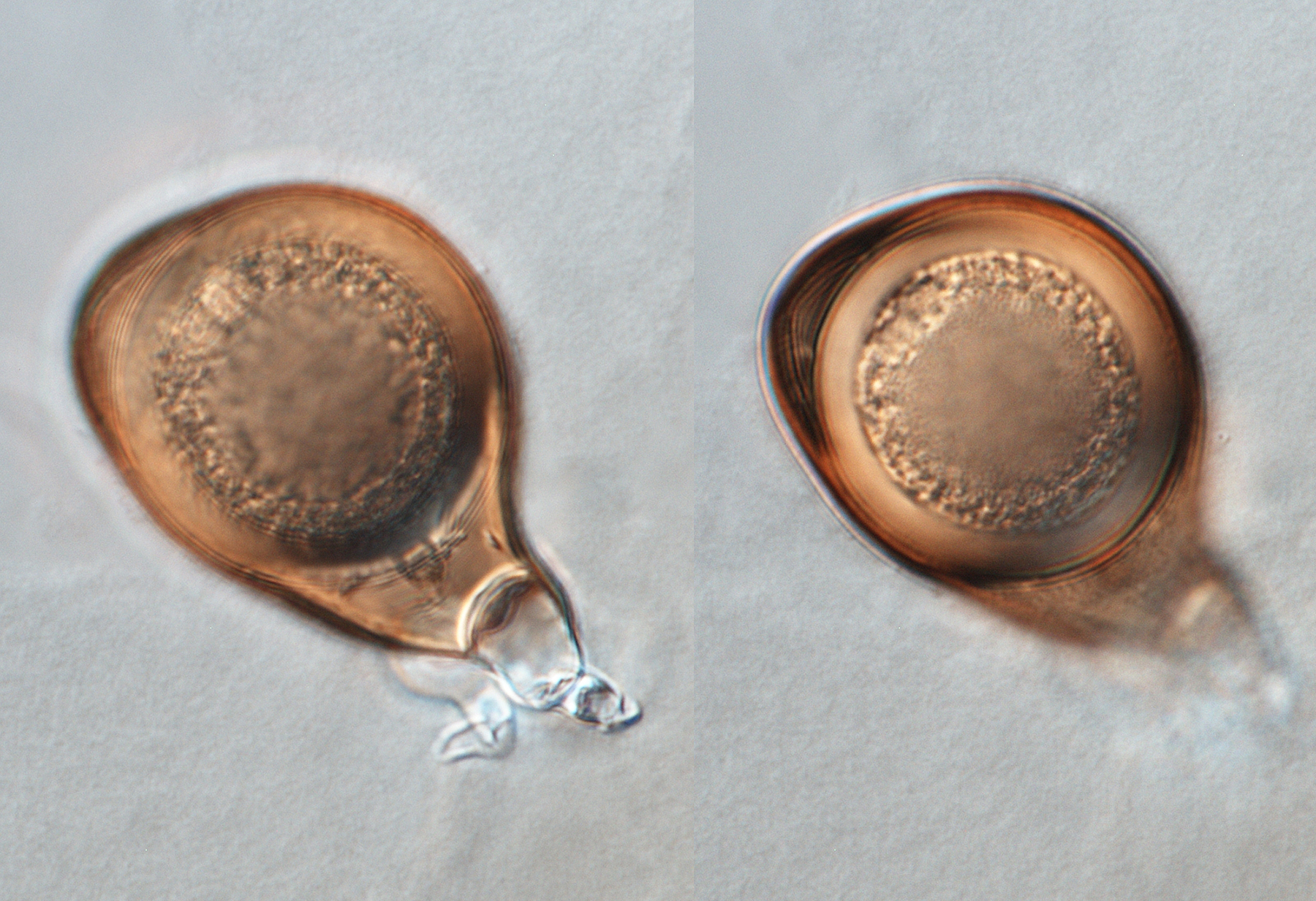 Phytophthora europaea nbsp;(CPHST BL 37G) sexual phase of the ex-type: older golden-brown plerotic oospore, oogonium with tapered base, and paragynous antheridium; photonbsp;by Vickie Brewster, USDA APHIS PPQ.
Phytophthora europaea nbsp;(CPHST BL 37G) sexual phase of the ex-type: older golden-brown plerotic oospore, oogonium with tapered base, and paragynous antheridium; photonbsp;by Vickie Brewster, USDA APHIS PPQ.
Phytophthora europaea (CPHST BL 37G) sexual phase of the ex-type: older golden-brown plerotic oospore, oogonium with tapered base, and paragynous antheridium; photo by Vickie Brewster, USDA APHIS PPQ.
Phytophthora spp. in subclade 9d: portion of the seven-loci ML phylogeny featuring the type cultures of 212 described species (by T. Bourret). Notice the position of P. fallax Ex-type CBS 119109 = S&T BL 63. Gloria Abad, USDA S&T.
Phytophthora spp. in subclade 9d: Morphological Tabular key (PDF) and Tabular key legends (PDF) in IDphy2 KEY SECTION. Notice the data of P. fallax Ex-type CBS 119109 = S&T BL 63. Gloria Abad, USDA S&T.
.jpg) Phytophthora fallax (CPHST BL 170) colonies of a selected specimen grown for 7 days on (a) V8reg; Agar, (b) potato dextrose agar, and (c) malt extract agar; photo by Krysta Jennings and Leandra Knight, USDA-APHIS-PPQ
Phytophthora fallax (CPHST BL 170) colonies of a selected specimen grown for 7 days on (a) V8reg; Agar, (b) potato dextrose agar, and (c) malt extract agar; photo by Krysta Jennings and Leandra Knight, USDA-APHIS-PPQ
Phytophthora fallax (CPHST BL 170) colonies of a selected specimen grown for 7 days on (a) V8® Agar, (b) potato dextrose agar, and (c) malt extract agar; photo by Krysta Jennings and Leandra Knight, USDA-APHIS-PPQ
Phytophthora spp. in subclade 7a: portion of the seven-loci ML phylogeny featuring the type cultures of 212 described species (by T. Bourret). Notice the position of P. flexuosa Ex-type CBS 141201 = S&T BL 211. Gloria Abad, USDA S&T.
Phytophthora spp. in subclade 7a: Morphological Tabular key (PDF) and Tabular key legends (PDF) in IDphy2 KEY SECTION. Notice the data of P. flexuosa Ex-type CBS 141201 = S&T BL 211. Gloria Abad, USDA S&T.
Phytophthora spp. in subclade 6b: portion of the seven-loci ML phylogeny featuring the type cultures of 212 described species (by T. Bourret). Notice the position of P. fluvialis Ex-type CBS 129424 = S&T BL 64. Gloria Abad, USDA S&T.
Phytophthora spp. in subclade 6b: Morphological Tabular key (PDF) and Tabular key legends (PDF) in IDphy2 KEY SECTION. Notice the data of P. fluvialis Ex-type CBS 129424 = S&T BL 64. Gloria Abad, USDA S&T.
 Phytophthora fluvialis colonies of the ex-type grown for 7 days at 20deg;C on: (a) V8reg; agar, (b) carrot agar, (c) potato-dextrose agar; photo by Treena Burgess, Centre for Phytophthora Science and Management, Murdoch University, Australia
Phytophthora fluvialis colonies of the ex-type grown for 7 days at 20deg;C on: (a) V8reg; agar, (b) carrot agar, (c) potato-dextrose agar; photo by Treena Burgess, Centre for Phytophthora Science and Management, Murdoch University, Australia
Phytophthora fluvialis colonies of the ex-type grown for 7 days at 20°C on: (a) V8® agar, (b) carrot agar, (c) potato-dextrose agar; photo by Treena Burgess, Centre for Phytophthora Science and Management, Murdoch University, Australia
 mature nonpapillate sporangia formed on V8 agar flooded with soil extract: (a) broad ovoid, (b) ovoid (c) ovoid, extended internal proliferation (d) nested internal proliferation (e) catenulate hyphal swellings (scale bar = 25 micro;m); photos by Treena Burgess, Centre for Phytophthora Science and Management, Murdoch University, Australia
mature nonpapillate sporangia formed on V8 agar flooded with soil extract: (a) broad ovoid, (b) ovoid (c) ovoid, extended internal proliferation (d) nested internal proliferation (e) catenulate hyphal swellings (scale bar = 25 micro;m); photos by Treena Burgess, Centre for Phytophthora Science and Management, Murdoch University, Australia
mature nonpapillate sporangia formed on V8 agar flooded with soil extract: (a) broad ovoid, (b) ovoid (c) ovoid, extended internal proliferation (d) nested internal proliferation (e) catenulate hyphal swellings (scale bar = 25 µm); photos by Treena Burgess, Centre for Phytophthora Science and Management, Murdoch University, Australia
Phytophthora spp. in subclade 8c: portion of the seven-loci ML phylogeny featuring the type cultures of 212 described species (by T. Bourret). Notice the position of P. foliorum Ex-type CBS 121655 = S&T BL 168. Gloria Abad, USDA S&T.
Phytophthora spp. in subclade 8c: Morphological Tabular key (PDF) and Tabular key legends (PDF) in IDphy2 KEY SECTION. Notice the data of P. foliorum Ex-type CBS 121655 = S&T BL 168. Gloria Abad, USDA S&T.
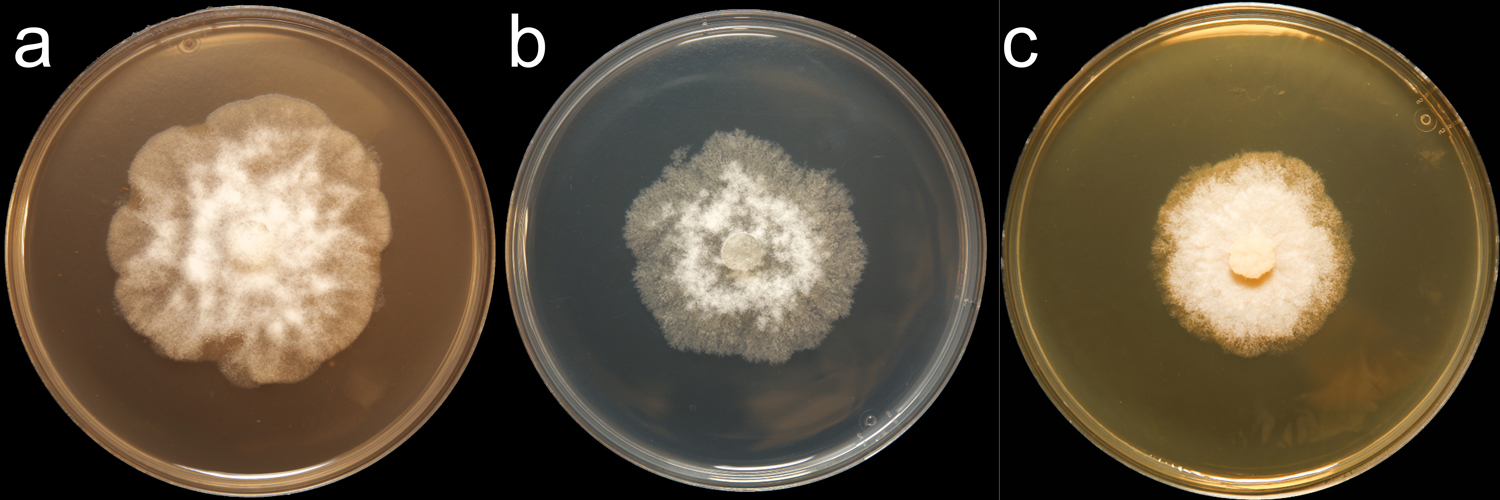 Phytophthora foliorum (CPHST BL 168) colonies of a selected specimen grown for 7 days on (a) V8reg; Agar, (b) potato dextrose agar, and (c) malt extract agar; photo by Krysta Jennings and Leandra Knight, USDA-APHIS-PPQ
Phytophthora foliorum (CPHST BL 168) colonies of a selected specimen grown for 7 days on (a) V8reg; Agar, (b) potato dextrose agar, and (c) malt extract agar; photo by Krysta Jennings and Leandra Knight, USDA-APHIS-PPQ
Phytophthora foliorum (CPHST BL 168) colonies of a selected specimen grown for 7 days on (a) V8® Agar, (b) potato dextrose agar, and (c) malt extract agar; photo by Krysta Jennings and Leandra Knight, USDA-APHIS-PPQ
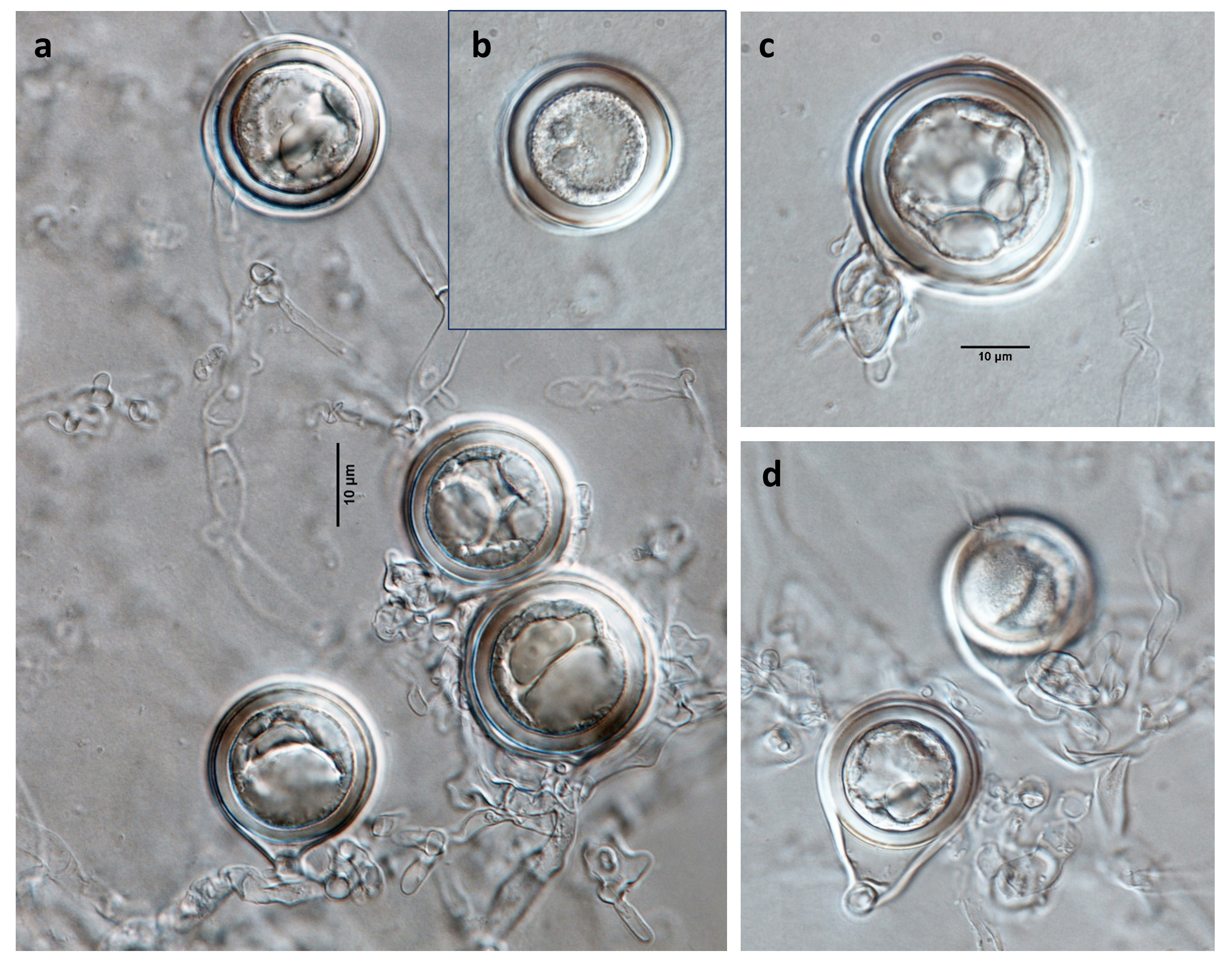 Phytophthora foliorumnbsp; (ex-type CPHST BL 168)nbsp;homothallic sexual phase: (andash;d) smooth-walled oogonia with paragynous antheridia and plerotic oospores; (d) oogonia with tapered bases and small paragynous antheridia; photos by Gloria Abad, USDA-APHIS-PPQ.
Phytophthora foliorumnbsp; (ex-type CPHST BL 168)nbsp;homothallic sexual phase: (andash;d) smooth-walled oogonia with paragynous antheridia and plerotic oospores; (d) oogonia with tapered bases and small paragynous antheridia; photos by Gloria Abad, USDA-APHIS-PPQ.
Phytophthora foliorum (ex-type CPHST BL 168) homothallic sexual phase: (a–d) smooth-walled oogonia with paragynous antheridia and plerotic oospores; (d) oogonia with tapered bases and small paragynous antheridia; photos by Gloria Abad, USDA-APHIS-PPQ.
 Phytophthora foliorum nbsp;(Ph168 selected specimen) homothallic sexual phase: (a, b, e) hyphal swellings and oospores; (bndash;e) smooth-walled oogonia with paragynous antheridia and plerotic oospores; (c) oogonia with tapered bases and small paragynous antheridia; (d) amphigynous antheridia; photos by Gloria Abad, USDA-APHIS-PPQ.
Phytophthora foliorum nbsp;(Ph168 selected specimen) homothallic sexual phase: (a, b, e) hyphal swellings and oospores; (bndash;e) smooth-walled oogonia with paragynous antheridia and plerotic oospores; (c) oogonia with tapered bases and small paragynous antheridia; (d) amphigynous antheridia; photos by Gloria Abad, USDA-APHIS-PPQ.
Phytophthora foliorum (Ph168 selected specimen) homothallic sexual phase: (a, b, e) hyphal swellings and oospores; (b–e) smooth-walled oogonia with paragynous antheridia and plerotic oospores; (c) oogonia with tapered bases and small paragynous antheridia; (d) amphigynous antheridia; photos by Gloria Abad, USDA-APHIS-PPQ.

